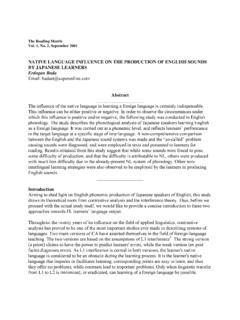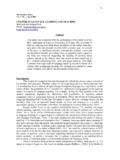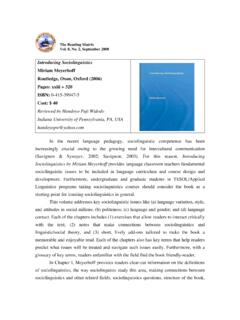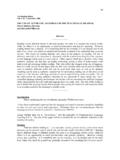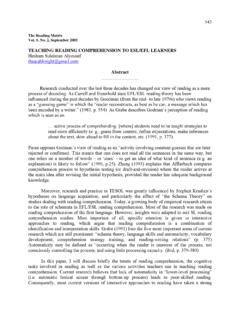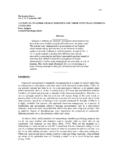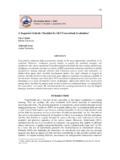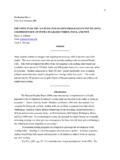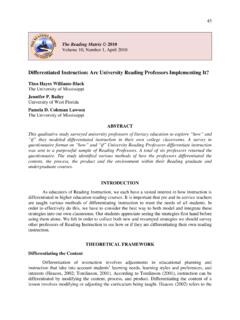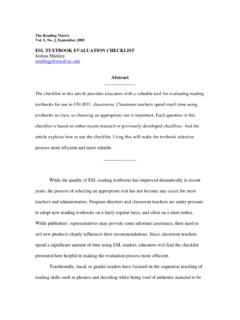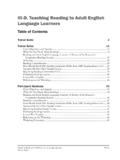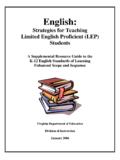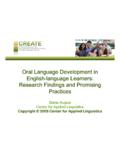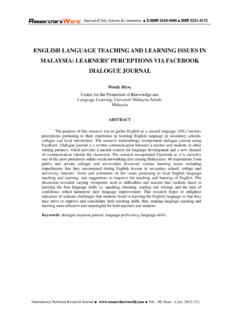Transcription of Reading Strategies: Adaptations to Meet the Needs …
1 22 The Reading Matrix 2009 Volume 9, Number 1, April 2009 Reading Strategies: Adaptations to Meet the Needs of Secondary english language Learners with Learning Disabilities Tiece M. Ruffin North Carolina Agricultural and Technical State University ABSTRACT Special education teachers working with secondary level english language learners (ELLs) with learning disabilities (LD) are often faced with the question of how to provide Reading comprehension instruction that meets the Needs of this unique group. If a learner has the dual diagnosis of ELL and LD, how does one provide effective instruction? This article looks at Reading strategies for improving the Reading comprehension skills of secondary level english language learners with learning disabilities. Adaptations are recommended so that the strategies are more appropriate for this unique and underserved population. INTRODUCTION Providing Reading comprehension instruction to secondary level english language learners with learning disabilities has long been a challenge not easy to answer.
2 Indeed, providing Adaptations to Reading strategies intended for use with students with learning disabilities is an important way to accomplish the goal of accommodating the learning Needs of english language learners with learning disabilities in Reading comprehension. Accommodations are needed because for a significant number of culturally and linguistically diverse students, english is not their first language . They are learning english as a second language and usually are labeled as limited english -proficient (LEP) or as english language learners (ELLs). In addition, some ELLs have difficulty understanding or speaking english because they may also have a learning or language disability (LD) that interferes with their learning processes. These students require special education instruction to assure that they achieve their fullest potential (Ortiz & Polyzoi, 1988). Furthermore, a national study by the Office of english language Acquisition (OELA) on LEP students with disabilities (SpEd-LEP) indicate that SpEd-LEP students represented 9% of the LEP K-12 population in 2001-2002 and of all special education students overall (Zehler, Fleischman, Hopstock, Stephenson, et al.)
3 , 2003). Furthermore, this study purports that the population of LEP students with disabilities has future projected growth, and therefore, the attention and immediate need to appropriately address and provide services to this unique 23 population is extremely significant (Zehler, Fleischman, Hopstock, Stephenson, et al., 2003). Based upon the aforementioned data, it is apparent that the enrollment of children with diverse linguistic backgrounds in special education services will only continue to increase. Thus, many special educators are faced with the challenge of adapting materials for ELLs. This article summarizes how to provide Reading comprehension instruction that meets the Needs of this unique group using appropriate and effective instructional features in the field of both ELL and LD. It also recommends tips for improving the Reading comprehension skills of secondary ELLs with LD by adapting strategies making them more appropriate.
4 Figure 1 explains the process for providing Reading comprehension instruction to these students. Figure 1. Culture, language , and Learning Disabilities How do special educators provide Reading comprehension instruction to secondary english language learners with learning disabilities? Dual Diagnosis Cultural and Linguistic Providing Effective Reading Adaptations to Reading Instruction Using Learning Strategies Strategies (specifically Reading comprehension strategies) Need for Adaptations Choosing Adaptations Recommend Adaptations Appropriate Reading Comprehension Strategies for ELLs with Learning Disabilities english language Learner Learning Disability 24 Providing Effective Reading Instruction A common form of intervention to provide high-quality instruction to ELLs with learning difficulties is the use of learning strategy instruction.
5 Learning strategies are defined as techniques, principles, or rules that enable a student to learn to solve problems, complete tasks independently, and increase their Reading comprehension (Mercer & Mercer, 1998). Research has shown that learning strategies are appropriate for students with special Needs who are culturally and linguistically diverse (Hudson & Fradd, 1987). Furthermore, ELL literature suggests learning disabilities affect learning in any language and must, therefore, be a guiding factor in designing instruction (Schwarz & Terril, 2000). If learning disabilities are the guiding factor in interventions and if Reading is the most common problem, it is imperative to look at learning strategies, particularly Reading strategies. Gersten, Baker, and Marks (1998) indicate that teaching all students, including ELLs with LD, how to read and understand what they read is essential. Research consistently reveals that a major reason many children with learning disabilities experience poor comprehension is due to a failure to read strategically and to spontaneously monitor their understanding of what is being read (Vaughn, Gersten, & Chard, 2000).
6 Additionally, Vaughn and colleagues (2000) assert that if strategies are taught to students with learning disabilities, improvements in Reading comprehension are likely to occur. Students with learning disabilities often experience deficits in comprehension; therefore, Reading comprehension strategies are relevant. Reading without comprehension seems pointless and not Reading strategically or employing a technique to monitor comprehension is likely to add frustration and anxiety to the reader causing significant difficulty with understanding in the Reading process. Students with learning disabilities must find meaningful ways to complete the task of gaining understanding from written text, and Reading comprehension strategies offer avenues for improving or increasing Reading comprehension. We next consider what Adaptations are relevant for Reading strategies intended for use with students with learning disabilities to be most appropriate for ELLs with LD.
7 Need for Adaptations Since some language learners have a learning or language disability and will require special education services, it is important to look at the type of instruction that would be beneficial for this group. Research findings on ELLs and LD suggest learning strategy instruction is an effective intervention which enables previously unsuccessful students with disabilities and ELLs to become effective learners (Chamot & O Malley, 1984; Deshler & Schumaker, 1986; Hudson & Fradd, 1987; Vaughn, Gersten, & Chard, 2000). Even though research recommends the use of learning strategies, researchers also contend that modifications need to be made to learning strategies to include salient instructional features of effective bilingual programs (Hudson & Fradd, 1987). However, the literature this claim is based upon has two assumptions. First, the teacher is fluent in the target non- english language . Second, the teacher has the assistance of at least one fluent, literate assistant who can provide non- english language support to accommodate language learning as well as academic skill development for students who are ELL/LD.
8 25 Apart from the study presented above, there is little research regarding modifications to learning strategies, specifically Reading strategies. It is important to apply modifications because there are many classrooms in which students speak five or six different languages. Choosing Adaptations Even though ELLs and students with LD have commonalties, ELLs have instructional Needs that are far different from those of native english speakers with LD (Gersten, et al., 1998). These instructional Needs suggest plausible Adaptations to Reading comprehension strategies intended for use with students with LD. Ortiz and Polyzoi (1988) present salient instructional features of effective bilingual programs. First, the use of the non- english language is important in mediating comprehension and developing english language proficiency. Second, for application to the general education classroom, english language skills must become an integral part of content area instruction.
9 Third, cultural relevance facilitates academic and social skills acquisition. Further, the control of vocabulary, opportunities to verbalize thoughts, comprehensible input, initial teaching strategies, strategies that build comprehension and other language abilities, and key instructional principles are suggested because the learning challenge for second- language learners is fundamentally different than that of monolingual students (Gersten et al., 1998). The use of ELL instructional Needs driving Adaptations to Reading comprehension strategies designed for students with LD represent embedding the learning Needs of language learners to Reading comprehension strategies. Monolingual or native speakers of english approach Reading from a different linguistic perspective, while second and foreign language learners approach Reading from a language acquisition perspective of learning how to speak, read, listen, and write a new language .
10 Gersten, Baker, and Marks (1998) describe a critical component of ELL instructional strategies to be comprehensible input, meaning students should be able to understand the essence of what is being said or presented to them. When input is comprehensible, students understand most aspects of what is required for learning the learning experience pushes them to further understanding. Research indicates the most promising instructional strategies for ELLs include providing students with opportunities to verbalize what they are learning and to receive feedback or encouragement from peers (Almanza, Singleton, & Terril, 1995-1996; Baca & Cervantes, 1991; Gansehow & Sparks, 1993; Vaughn, Gersten, & Chard, 2000). Additionally, the use of organizers, providing opportunities to use several senses, using learning strategies, recognizing and building upon learners strengths and prior knowledge, simplifying language , but not content, and making concepts accessible through the use of pictures and maps have been found to be successful.
